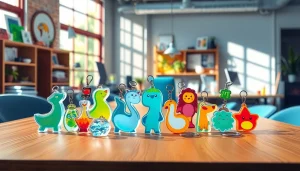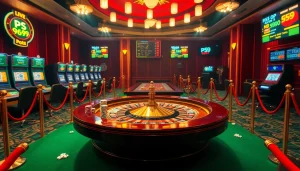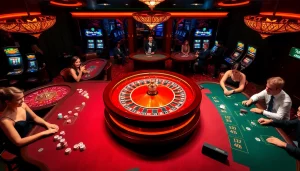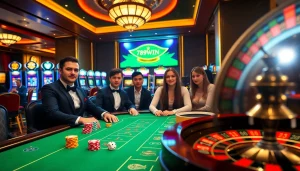The Ultimate Guide to Event Gamification in 2025: Boost Engagement Today!

Understanding Event Gamification
What Is Event Gamification?
Event gamification is the application of game design elements and principles in non-game contexts, specifically events like conferences, trade shows, or corporate meetings. The goal is to enhance participant engagement, motivate attendance, and create memorable experiences through interactive features that are inherently fun and rewarding. By incorporating gamified elements such as point scoring, competitions, and rewards, event organizers can transform mundane activities into thrilling challenges that captivate attendees and encourage participation.
In the realm of event gamification, various strategies can be employed. These include, but are not limited to, creating leaderboards, offering badges for completion of tasks, and integrating real-time feedback mechanisms. The simplistic premise of gamification lies in its ability to tap into our natural instincts for competition and achievement.
Benefits of Event Gamification for Engagement
The benefits of incorporating gamification into events are manifold, leading to heightened engagement and improved participant satisfaction. Some key advantages include:
- Enhanced Engagement: Gamification captures attention through interactive content and competitive elements that encourage attendees to immerse themselves fully in the event.
- Increased Motivation: By offering incentives such as prizes and recognition, participants are more likely to engage with exhibitors, attend sessions, and explore the event’s offerings.
- Stronger Networking Opportunities: Gamified interactions often require teamwork or collaboration, which can lead to new professional relationships and a more connected attendee experience.
- Data Collection: Gamification allows for seamless data collection on attendee behavior, preferences, and engagement patterns that can improve future events.
- Memorable Experiences: Transforming the event into a game sets the stage for unique, enjoyable experiences that resonate with participants long after the event ends.
Key Terms in Event Gamification
Understanding the terminology associated with event gamification can provide valuable insights into this innovative practice. Some fundamental terms include:
- Game Mechanics: Fundamental components of games such as points, badges, leaderboards, and challenges.
- Experience Points (XP): A system to reward participants for completing tasks, which contributes to an overall score or ranking.
- Leaderboards: A real-time ranking display that showcases participant achievements and fosters competition.
- Badges: Visual representations of accomplishments or mastery of certain tasks, serving as milestones during the event.
- Challenges: Specific tasks or missions that participants can complete for points or rewards.
Strategies for Implementing Event Gamification
Choosing Game Mechanics for Your Event
When implementing event gamification, the selection of appropriate game mechanics is crucial in engaging attendees. Depending on the event type and audience, various game mechanics can be adapted:
- Point System: A straightforward point system rewards participants for various actions, such as attending sessions or visiting exhibitor booths.
- Competitions: Hosting challenges where participants compete against one another boosts excitement and engagement.
- Quests: Designing quests can enhance attendee exploration, encouraging them to interact with different elements of the event.
- Feedback Loop: Continuous feedback through live updates keeps participants informed about their standings and encourages ongoing participation.
Integrating Technology: Tools and Software
Before executing an event gamification strategy, it’s essential to select the right technology that can support your gamified elements. Several tools exist to facilitate gamification in events:
- Event Apps: Customizable mobile apps allow for real-time updates, leaderboards, and participant engagement through game mechanics.
- Polling Tools: Tools that allow for instant feedback and responses from participants, effectively integrating gamified Q&A sessions.
- Social Media Integration: Encourage sharing through social media to create a buzz around the event and amplify engagement.
- Data Analytics Software: Utilize analytics to gather insights on engagement, popular activities, and areas for improvement.
Best Practices for Effective Gamification
To maximize the impact of gamification at your event, consider these best practices:
- Define Clear Objectives: Establish what you aim to achieve through gamification, such as increased networking, attendance, or feedback.
- Understand Your Audience: Tailor game mechanics that resonate with your target demographic for maximum engagement.
- Keep It Simple: Ensure that the rules and mechanics are easy to understand to avoid overwhelming participants.
- Incorporate Feedback: Use participant feedback to make real-time adjustments and enhance the gamification experience.
- Celebrate Success: Acknowledge winners and outstanding performances to encourage competition and maintain motivation.
Examples of Successful Event Gamification
Case Study: Gamified Corporate Events
A standout example of successful gamification can be seen in corporate events like company retreats or training sessions. One notable instance involved a leading tech firm that incorporated gamified elements into its annual corporate retreat by introducing a “Sales Quest” competition. Each department was transformed into a team, competing to achieve specific goals throughout the event.
Points were awarded based on team collaboration, attendance in workshops, and networking efforts. Participants could win badges signifying their accomplishments, which fostered healthy competition among teams. This approach not only boosted engagement but also enabled team members to learn more about the company’s core initiatives in a dynamic, interactive setting.
Esports Events: Engaging Participants through Gamification
Esports events serve as prime examples of how gamification heightens engagement. In organized tournaments, players are rewarded with points for achieving specific in-game objectives, which translate to tangible rewards such as merchandise or entry into exclusive competitions.
One major esports tournament utilized a triple-layered rewards system, combining in-game achievements, fan voting for team support, and social media engagement to enhance the overall participant experience. This multifaceted gamification strategy not only attracted a larger audience but also fostered a strong community feeling among gamers and fans alike.
Innovative Uses of Gamification in Trade Shows
Trade shows have notably embraced event gamification to drive foot traffic and enhance exhibitors’ experiences. In a recent technology-focused trade show, organizers developed an interactive scavenger hunt that challenged attendees to visit various booths to collect virtual tokens.
Upon collecting enough tokens, participants entered a grand prize drawing. This strategy not only increased booth visits but also facilitated meaningful conversations between exhibitors and attendees, resulting in higher engagement rates and improved overall satisfaction at the event.
Measuring Success in Event Gamification
Key Performance Indicators to Track
Measuring the success of gamification efforts is crucial in determining their effectiveness at an event. Key performance indicators (KPIs) to track include:
- Participation Rates: Measure the percentage of attendees who engage with the gamified elements, such as completing challenges or visiting booths.
- Time Spent on Activities: Analyze how long participants engage with gamified elements, providing insights into their interest levels.
- Feedback Scores: Collect participant feedback on the gamified experience through surveys to gauge satisfaction and enjoyment.
- Social Shares: Monitor how often participants share their experiences on social media relating to the gamified aspects of the event.
Analyzing Participant Feedback
To improve future events, it’s essential to analyze participant feedback comprehensively. Tools such as post-event surveys or real-time feedback applications can provide insights into which gamified elements resonated with attendees. Look for trends in feedback, focusing on what participants enjoyed most and what can be improved. This iterative process can significantly enhance the setup of future events as organizers learn directly from their audience.
The Role of Data in Improving Future Events
Incorporating analytics into your event strategy facilitates data-driven decision-making. Use data collected from participant interactions to identify effective gamified elements versus those that didn’t yield the desired engagement levels. Additionally, understanding attendee demographics and behaviors through data can help in customizing gamification strategies for future events, ensuring that they better cater to target audiences.
Future Trends in Event Gamification
Emerging Technologies Shaping Gamification
The future of event gamification is increasingly intertwined with emerging technologies. With advancements in augmented reality (AR) and virtual reality (VR), event organizers can create immersive experiences that blend the virtual and physical worlds. For example, using AR in a gamified scavenger hunt can enrich the experience by allowing participants to interact with digital objects that overlay the real environment.
Additionally, artificial intelligence and machine learning could personalize the gamification experience, offering tailored challenges based on individual participant preferences collected throughout the event.
Predictions for 2025 and Beyond
Looking ahead to 2025 and beyond, we can expect gamification to evolve alongside technology. Events will likely feature hyper-personalization, where attendee experiences are uniquely tailored based on past interactions and preferences. Moreover, gamification may extend beyond events, becoming an integral component of ongoing community engagement within industry networks.
As organizations strive to maintain connections with attendees, continuous gamified experiences could keep audiences engaged year-round, fostering a sense of community long after the event concludes.
Adapting to Changes in User Preferences
As societal trends shift, so too must gamification strategies evolve in response to changing participant preferences. Recent years have shown a surge in desire for flexibility and personalization within the event experience. Organizers must remain attuned to these trends, experimenting with different formats, challenges, and engagement techniques to maintain relevance among their audience.
Ultimately, adapting to user preferences will be the key to sustaining participant interest and driving future success in event gamification. Continuous learning and innovation will ensure that gamified strategies remain engaging and effectively enhance the event experience.






